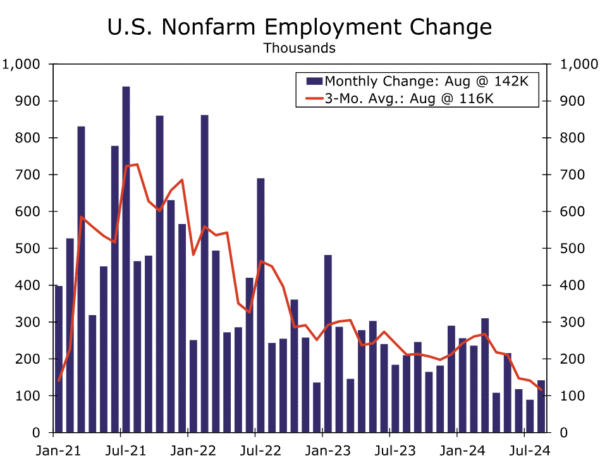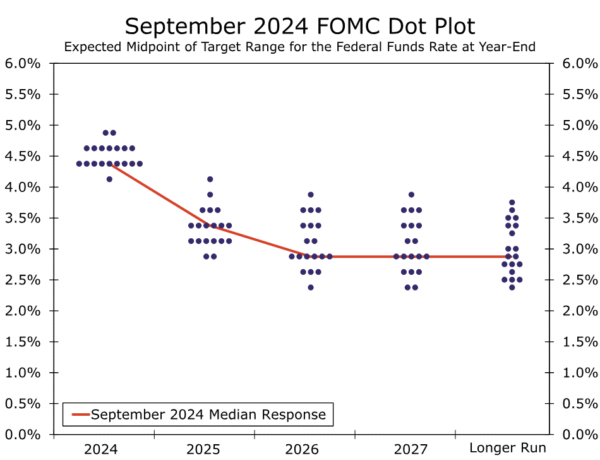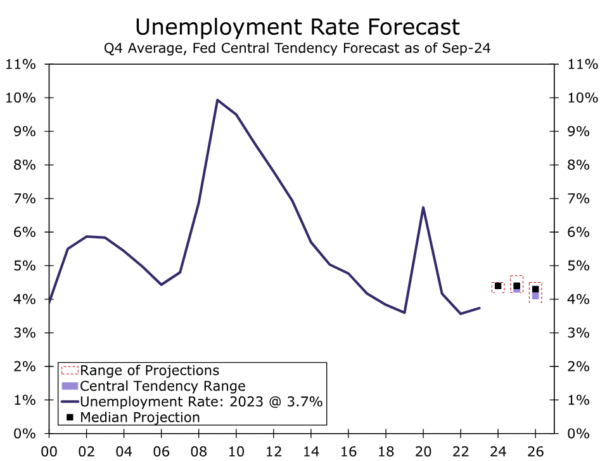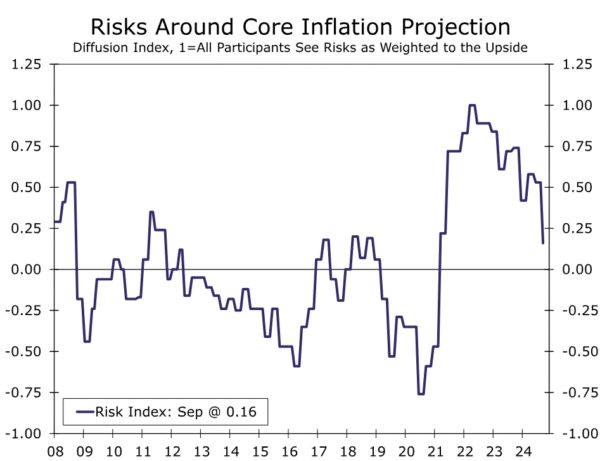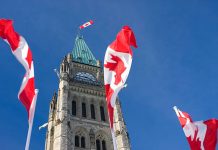Summary
- The FOMC surprised some market participants today by reducing the target range for the federal funds rate by 50 bps. Concerns about the state of the labor market appear to have been the primary driver of the 50 bps move.
- But the FOMC signaled that it may not necessarily follow today’s 50 bps rate cut with additional large reductions in upcoming meetings. The median dot in the so-called “dot plot” implies two 25 bps cuts if further easing is spread evenly over the two remaining meetings this year.
- Only one voter (Governor Michelle Bowman) dissented at today’s policy meeting, preferring a 25 bps rate cut instead, but the dot plot indicates that a meaningful share of the Committee appears to be in no hurry to reduce the fed funds rate at a rapid clip.
- The FOMC may indeed slow the pace of rate cuts in coming meetings. But we remain of the view that monetary policy will be back near neutral in one year’s time. That is, we look for the federal funds rate to be roughly 3.00%-3.25% or so by this time next year. We will formally update our meeting-by-meeting fed funds forecast in the coming days.
FOMC Front Loads Easing Cycle
Heading into today’s FOMC meeting, there was more uncertainty among market participants about the outcome than there has been in some time. A rate cut, which would be the first since March 2020, was universally expected. But would the Committee reduce the target range for the federal funds rate by 25 bps or 50 bps? In the event, the FOMC decided to cut rates by 50 bps. The vote was 11-1 in favor, with the lone dissent coming from Governor Michelle Bowman. Just one dissent is not uncommon, but it is more uncommon for a member of the Board of Governors to vote against the policy decision. Today marks the first governor to dissent since 2005, and the first governor to dissent in favor of tighter policy since 1994.
The post-meeting statement highlighted the cooling in the labor market, saying that job gains had “slowed.” In that regard, the economy created 267K jobs per month in the first quarter of the year, but that pace has nearly halved over the past three months (Figure 1). The statement also seemed to hint that concerns about the labor market had been the primary driver of the 50 bps move with the line “in light of the progress on inflation and the balance of risks [emphasis ours], the Committee decided to lower the target range for the federal funds rate by 1/2 percentage point.” The idea that the risks are skewed to the downside for the labor market was further reinforced by the addition of a line signaling that the Committee is “strongly committed” to supporting maximum employment in addition to the existing line about returning inflation to 2%.
Summary of Economic Projections Highlights More Balanced Risks
The update to the Summary of Economic Projections (SEP) suggests today’s 50 bps cut was an effort to front-load the removal of policy restriction, and that additional 50 bps cuts may not occur at upcoming meetings without a meaningful deterioration in the economy. The median participant projection for the fed funds rate at year-end slipped to 4.375%, implying two 25 bps cuts if further easing is spread evenly over the two remaining meetings this year (Nov. 7 and Dec. 18). However, seven Committee members projected rates to fall only 25 bps further this year, while two projected no change (Figure 2). In other words, only one voter may have dissented in September, but a meaningful share of the Committee is still in no hurry to reduce the fed funds rate.
The disconnect between today’s action and the outlook for additional easing in the near term may stem from uncertainty about where the neutral policy setting is. The median estimate of the longer run fed funds rate rose a tick to 2.9% in September, but the range remains wide at 2.4%-3.8%. Yet by that measure, even the more hawkish members of the Committee seem to agree that the prior policy rate of 5.25%-5.50% was very restrictive, allowing space to reduce the target range without inadvertently venturing into “accommodative” territory.
Participants expect further easing in 2025, although at potentially a slower pace. The median dot for 2025 shifted down to 3.375%, implying 100 bps further easing next year.
The more balanced risks between the inflation and employment side of the Fed’s mandate were evident in the economic portion of projections. The median estimate for the unemployment rate at year-end rose to 4.4% from 4.0% in June, slightly higher than most participants’ longer-run estimates, and is expected to stay at 4.4% in 2025 (Figure 3). Meantime, Committee members seemed more constructive on the inflation outlook. The median estimate for headline inflation in Q4-2024 fell from 2.6% to 2.3%. The FOMC also projects core inflation to descend a touch faster than it did in the last SEP; the median estimate slipped to 2.6% for 2024 and 2.2% for 2025 compared to 2.8% and 2.3% previously. Notably, 16 of 19 participants now see the risks to core inflation as broadly balanced, compared to only seven at the June meeting (Figure 4). At the same time, the majority of the Committee (12 participants) believe the risks to the unemployment rate lie to the upside versus only four when the Committee met in June.
Coming into today’s meeting, we expected a 25 bps rate cut today followed by a pair of 50 bps rate reductions at each of the November and December meetings for a cumulative 125 bps decline in the federal funds rate by year-end. With today’s decision by the FOMC, a 50 bps move came a bit faster than we were anticipating, but our overarching view that the FOMC will ease materially in the coming months has not changed. It will be a close call whether we get another 50 bps move by year-end or if the Committee slows down to a more-measured 25 bps pace. The employment reports that are slated for release in the next three months will be critical inputs into the FOMC’s decisions at the November and December meetings. We will formally update our meeting-by-meeting fed funds forecast in the coming days, but we remain of the view that monetary policy will be back near neutral in one year’s time. That is, we look for the federal funds rate to be roughly 3.00%-3.25% or so by this time next year.




